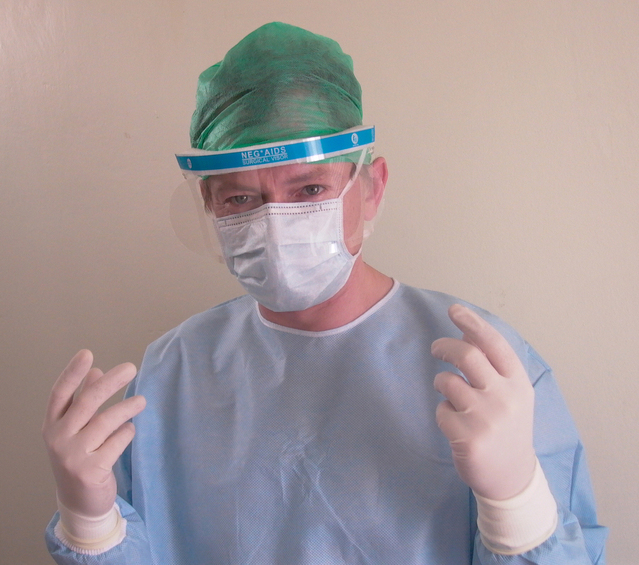Your primary care doctor has been nagging you for years. Your wife and brother seem to be in on the scheme too. Every once and a while one of your coworkers even says (with a chuckle) “C’mon Bob, you’re fifty-seven, you really need to get it done!”
“OK, enough,” you finally say, “I’ll go for a colonoscopy!” So at your next visit you ask your primary doctor how to set it up and he gives you the name of a local gastroenterologist to call. After a week or two, you finally build up the courage to call the office and say proudly, “Hi, I want to schedule a colonoscopy!”
“Have you seen the doctor already sir?” asks the receptionist.
You answer, “No, but Dr. Jones is my primary, he can send over all my records. I just need a colonoscopy.”
“You need to make an appointment to see the doctor first sir, then we can schedule the colonoscopy,” says the receptionist.
You think to yourself, ‘Seriously? What is the point of seeing the doctor first…so he can get more of my copays? What is there to talk about? Why can’t I just make the appointment for the test? Now I have to take more time off from work too. How did I let myself get talked into this?‘
 Apparently, researchers at Johns Hopkins University School of Medicine had similar questions, and tried to answer them in a study published in The Journal of the American Medical Association this month. The authors looked at insurance claims for over 842,000 screening and surveillance colonoscopies done on patients 50-64 years of age, and concluded that a precolonoscopy office visit resulted in a mean payment of $123 by insurers. If you average this across all of the patients in the study, this results in an additional $36 per colonoscopy performed.
Apparently, researchers at Johns Hopkins University School of Medicine had similar questions, and tried to answer them in a study published in The Journal of the American Medical Association this month. The authors looked at insurance claims for over 842,000 screening and surveillance colonoscopies done on patients 50-64 years of age, and concluded that a precolonoscopy office visit resulted in a mean payment of $123 by insurers. If you average this across all of the patients in the study, this results in an additional $36 per colonoscopy performed.
This is interesting, since the majority of patients in this study (about 70%) did not have precolonoscopy visits, instead an “open-access” model was used. Open-access refers to a program where a primary care doctor can directly refer pre-selected patients for colonoscopy without the patient having to meet the gastroenterologist first. Usually, this consists of filling out a checklist to make sure that the patient is truly only in need of a screening colonoscopy. That is, the patient must be asymptomatic, with no family history of colon cancer, and without several key signs/symptoms (e.g., rectal bleeding, iron-deficiency anemia, abdominal pain, chronic diarrhea, etc.)
In open-access colonoscopy, the primary care doctor takes on an additional paperwork and administrative burden in favor of saving the healthcare system $123 per colonoscopy. One might think, ‘Fine, that only adds about one minute of the doctors time.‘ However in reality, the patient will likely have some questions for the referring doctor: Questions about the colonoscopy, about the gastroenterologist, about insurance coverage, about diet, about bowel prep, about what to do with their medications (especially aspirin and other blood thinners), about the risks, about getting to the endoscopy suite, etc. All of these questions will take additional time to answer and impose an additional workload on the already over-burdened primary care doctor and his or her staff. Alternatively, given the above constraints, these questions may not get answered at all.
Here in Long Island, NY where I practice, it seems to be the norm to have a precolonoscopy visit. This visit serves several important purposes in my mind: I can meet the patient, take a history, and make sure that they actually need a screening colonoscopy. I can answer all of the above questions in more detail than the primary doctor can. I also get to give them my basic talk about the purpose of a colonoscopy, how and why we remove polyps, the importance of good bowel prep and how to do it, and the small associated risks of a colonoscopy. We can talk about what to do with medications, and where to arrive on the day of the test, and parking, and all those seemingly small details that can make a patient stressed-out about the test for no good reason.
I can also make sure that there are no other issues going on with the patient. A significant number of “screening colonoscopy” patients actually turn out to have other complaints, most commonly rectal bleeding, weight loss, chronic constipation or diarrhea. Since these are often embarrassing things for patients to volunteer, and since primary care doctors don’t have the time to spend their entire visit discussing the GI tract, these complaints often never make it out of the patient’s mouth. Many patients, realizing that something might be wrong, will instead ask for a colonoscopy rather than saying “I’ve been losing weight and seeing blood in the toilet for three months.” When asked directly at the time of their precolonoscopy visit, the truth usually comes out.

“Hi I’m Doctor Smith from the open-access colonoscopy clinic, nice to meet you. Please bend over now.”
There is another benefit to the precolonoscopy visit that is not talked about in studies: It is the patient’s time to interview me too! Am I someone that they feel comfortable with? Do I seem to know what I am doing? Is the office clean? Do my hands shake? What if I have to give them bad news…do they trust me to take the next steps in their care? I find that for many patients the words colonoscopy and anxiety seem to go hand-in-hand. Hopefully by meeting me ahead of time, most of this anxiety can be eliminated.
Here are some other points I think should be included in the next study of precolonoscopy office visits vs. open-access colonoscopy:
- How many patients actually follow through with the procedure?
- What is the anxiety level of the patient?
- How well does the patient understand the purpose of the test?
- Can the patient articulate the risks of the procedure that they signed up for?
- What is the quality of the bowel prep between the groups?
- What is the quality of the actual procedure as defined by:
- Adenoma detection rate?
- Number of procedures that need to be repeated due to poor prep or other factors?
I’m not saying that open-access is bad. In fact, it can probably be a good cost- and time-saving measure for selected patients (namely motivated, health-literate patients without any major medical problems). However we must remember that sacrificing cost usually also sacrifices quality. For an average of $123, a patient can be better informed, less anxious, and better prepared for having a well-lubricated 6-foot-long flexible tube gently and expertly stuck where the sun don’t shine, all in the name of preventing colon cancer. Isn’t that worth paying for?
If you enjoyed this article, sign up for our free newsletter and never miss a post!
Reference:
Riggs KR, Segal JB, Shin EJ, et al. Prevalence and cost of office visits prior to colonoscopy for colon cancer screening. JAMA 2016;315:514-5.
Images via:
(money) freeimages.com/Nerijus J
(doctor) freeimages.com/Adam Ciesielski
